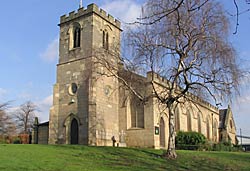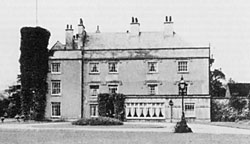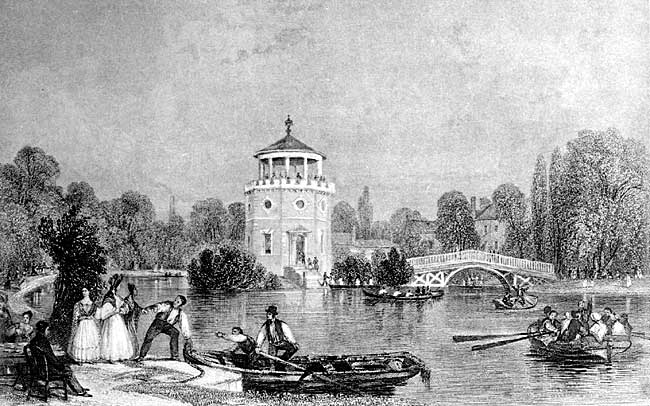
St Peter's church, Radford (photo: A Nicholson, 2005).
St. Peter's Church. St. Peter's Parish Church was, about 1790, described by Throsby as "little and in disorder," and afterwards by Stretton as "in a ruinous state," but in 1810-12 it was rebuilt at a cost of £2,000, Lord Middleton giving £200, George de Ligne Gregory, Esq., £200, etc. The chancel was added in 1872. The Rev. S. Cresswell was for fifty-two years curate or vicar. He was a Horticulturalist. The Rev. C. Lea Wilson followed in 1880, and 1913 is closing by retirement an active and useful ministry.
Old Radford. The original village clustered round the parish church, but clinging to the Leen in what is now called St. Peter's Street. All the old wattle and daub huts, and most of the old houses, have passed away, but there are a few aged houses in the street named. The "White Horse" public-house had on it the date of 1661, but it has recently been rebuilt. There is an old house at the Mill-in-the-hole. Of the small cottages, those built one hundred years ago have had their life-time, are very defective in regard to the essentials of a house—sufficient space, air, light, water, a sink, a pantry, and sanitary conveniences. Many of them will have to be swept away, but as new houses cannot be built except at about double rents, and we do not want block dwellings, or flats, or joint occupations, or single rooms, efforts must be made to improve and brighten some of the existing ones. The yard called Torcross Cottages shows how back houses may be improved and adorned with plants, but the cost has been too much to pay.
On the western side of Old Radford has been built All Souls' Church, 1894, adjoining the new park. The Congregationalists (1860), Primitives, United Methodists, have chapels, and the Roman Catholics have schools. An Adult School and a Brotherhood have the building formerly called the Redoubt Street Mission. Very large Council Schools adjoin the Boulevard. There is a free Reading Room, and factories for lace-making, jacquard card building, toys, etc. At the bottom of Ilkeston Road there are four public-houses in the space of one hundred yards, and others near by. Why? What for? Possibly it is a legacy of 1832, when there were in the parish thirteen inns and taverns, and twenty beerhouses, but the excessive supply ought not to continue.
Cobden Park is not a park, but a number of streets— formerly fields—east, south, and west of the old Cotton mill, off Ilkeston Road.
On the eastern side of the church are the great tobacco works of Messrs. Player, the lace factories of Messrs. Perry. A. C. Radford, the Clyde Works, and other firms. The church of St. Michael and All Angels, built in 1889, with its adjoining hall, the chapel of the Primitives (1898), the Alfreton Road Council Schools, the Training Institution, etc., are here located.

Aspley Hall, c. 1925.
Aspley. Aspley Woodhouse, now Aspley Hall, by its name and its grand old trees, reminds us of forest days, for Aspley is the remains of an ancient wood extending into Wollaton and Bilborough, and this site has been a residence since the days of Queen Elizabeth, by whom the herbage and pannage (pasturage for cattle and swine) in Aspley Wood was sold, since which the property has passed from the Blyth family to the Atkinsons, and Willoughbys, and in 1786 it was sold to Lord Middleton, and has been a kind of dower house to Wollaton Hall. (See the tradition as to Agnes Willoughby, page 50, and "Notts. Facts and Fictions," page 6).
The Willoughbys, of Aspley, refused to change their form of faith at the bidding of the monarch, or parliament, and continued as Roman Catholics long after other families had conformed. In 1722 Francis Willonghby was fined £48 6s. 8d. for not taking the oath, which contained not only a promise of allegiance, but also a declaration that no foreign potentate had any jurisdiction, temporal or spiritual, in this realm. Pains and penalties could not make the old Squire budge. In 1767 Edward Willoughby was the Squire, and was called "His Honour," and his wife "Madam." It was their custom on Shrove Tuesdays to give the tenants a treat consisting of pancakes, in the kitchen at Aspley Hall, but each mother present must fry them for her family, and when the cakes were fried on one side, must toss them in the air, and catch again in the pan, unless, amid roars of laughter, the cakes fell into the fire, "His Honour" and "Madam" joining in the fun. Each man had a quart of ale, and each woman a pint. Eight or ten families would be in the kitchen at one time. An old gentleman in black was always present, and blessed the proceedings. He was a Roman Catholic priest, the Rev. Thomas Pickering, who continued as priest at Aspley for fifty years, liable to penalties, but kindly and quiet. He died March 24th, 1789, aged eighty-six year?, and his gravestone may be seen under a tree in Old Radford Churchyard.
Bobbers Mill. Bobbers Mill is referred to in the reign of Henry II. (1154-89), for a marc of silver was directed to be paid annually out of the rents of a certain mill npon the River Leen, called Boboursmilne, to Lenton Priory, in order that the monks might pray for the soul of Walter de Kyme; hence Kyme street, in Radford, is so named to keep Walter in remembrance.
Alfred R. Cooke, in 1851, wrote a poem of pity to the poor Leen, commencing—
"Blest Bobbers Mill! how graceful didst thou stand
Ere thy fair landscape knew the spoiler's hand." And —"Blest vale! ere Manufactures cruel power By greed
impelled, sought first thy peaceful bower," etc.
The imputation of greed is uncalled for. People must live by labour, but it is highly desirable the pollution of the river should be lessened. An act was passed in 1872 for making an intercepting sewer, and it was then thought that the original purity of the stream would be speedily restored. This has not been accomplished.
The flour mill continues, but on a much larger scale, and Bobbers Mill has become quite a place for manufactures. There are factories for lace, leather, hosiery, colour printing, timber, mineral waters, bleaching, dyeing and dressing, etc., all telling of industrial activity, but that unfortunate level railway crossing—a railway without a station, and there being no tramways, is a great hindrance.
There is a United Methodist Chapel.

Radford Folly.
Radford Grove. Radford Grove, or Folly, has had a varied experience. In 1790 it was described by Throsby as being "a little paradise." Mr. W. Elliott in 1780 made grounds in miniature, with foliage blended in groups, and temple forms, an ornamental lake, etc., so making the place "delectable." The beauty, however, faded, the paradise was lost, and men called the Grove "the Folly." It became a place of public entertainment, and the poet says of the Leen that it—
"Famed Badford Folly left with pious haste."
Mary Howitt, in her book "Little Coin, Much Care," also refers to the place, and the evening's grand entertainment, to be concluded by fireworks. Mr. R. Sutton bought it, and stocked the lake with perch and the banks with rare birds, and Henry S. Sutton wrote in 1843 one of his poems, "A Dream," under the heading—
"There is a spot of earth supremely blest, A
dear, and sweeter spot than all the rest."
And so the paradise had been regained. But alas! although Blondin walked there, the beauty finally departed, the lake was filled up, the ornamental bridge removed, the gallery with canopy taken down, and the "delectable gardens" became the approach to a colliery wharf !
New Radford. Until 1796 all the part of the parish from Old Badford church to the top of Derby Road was fields and gardens. In 1796 Benjamin Darker, needle-maker, built four houses, back to back, being Nos. 19 and 21, now called Burke Street, and two in the rear, in Darker's Yard. He then built nine others adjoining, and reaching to Denman street. The land cost 2s. per yard. He insured the thirteen houses in the Phoenix Fire Office for £500, and paid 10s. premium, and 7s. 6d. for a duty then very unwisely imposed by the Government. The district was in the policy called "New Weston," not New Radford. Of course, there were no sewers, and many years passed before there was much advance with regard to water supply, but in 1824, Joshua Beardmore, a tallow-chandler, sunk a well in Holden street, sixty yards deep, and with a steam engine pumped water into a tank, and sent a man round with a cart selling the water at a halfpenny a bucket. He afterwards established water works at Sion Hill (now Mr. Alton's) and had a system of pipes under the streets, and subsequently he sold the whole to Messrs. Walker, and they continued the supply, but willingly ceased on receiving, it is said, £5,000 compensation for the goodwill of supplying with water the people of Radford and the Park.
Mr. James Fisher pumped water at his factory, and had a service of pipes to the houses in the locality, until in some way the water was said to be contaminated, possibly through a fissure in the rock, and the sale was discontinued.
The district was nightly patrolled by a watchman, who called out the hour, and collected his stipend weekly from the principal property owners.
George de Ligne Gregory was the lord of the manor, and three streets were named after him, but the "George" was at the annexation absurdly re-named "Moorgate," and "Gregory" was converted into "Holden." The old borough was cramped with the burghers' rights (until the Inclosure Act of 1845 authorised sale and compensation), and land on which to build could not be had, but Radford, with its gardens, was free, and might have been made into a little paradise, but, alas, narrow streets and "courts" and "yards" were crowded on the lovely site.
The Church. Was it owing to poverty, or was it spiritual apathy, that caused the Church people to make no spiritual provision beyond the parish church at Old Radford for fifty years, when the population had become over ten thousand, and there were fourteen nonconformist chapels in the seven hamlets then included in the parish? The first chapel seems to have been built in 1798, in Chapel street, of which it is recorded, "a Sunday school was established in 1800, and was the only Sunday school (in the villages) within a circuit of several miles, and children from Basford and Bilborough regularly attended." The Wesleyans followed in 1805.
Christ Church is named in 1844 as then being in course of erection, but it was not consecrated until 1847. It has now extensive Sunday and Day Schools, a Mission Hall, etc. The Rev. T. Pyper was Vicar from 1867 to 1902. In the Day Schools Mr. W. Williams, M.A., has been the valued Head Master for 80 years, and some of the boys have made a splendid success.
There are large Council Schools, and the Public Baths, Bethel Chapel (1857), etc., and great factories for the manufacture of lace, cotton doubling, hosiery, embroideries, bobbins and carriages, and other industries.
